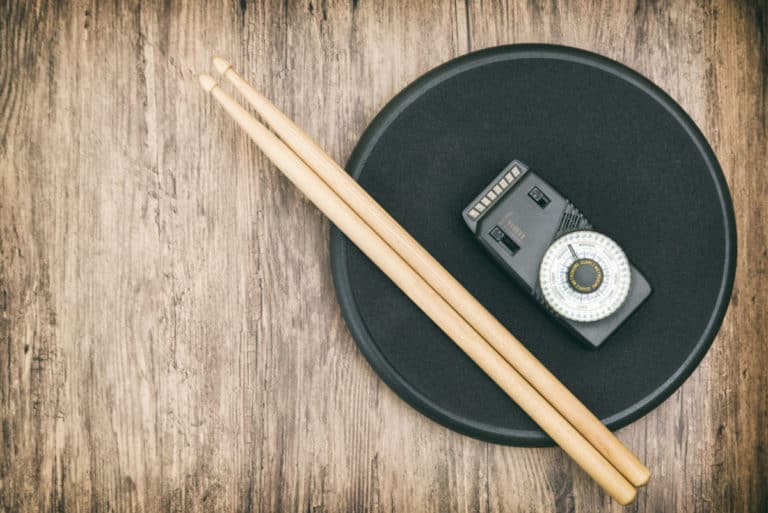How Long Does It Take To Learn Drums?
You’ve probably never met a single person who’s ever said, “Boy, I sure am glad I quit learning a musical instrument when I was a kid.” Many adults look back and wish they had learned something, and many decide to take one up, hoping that it’s never too late.
Learning the basics of playing the drums can take just a couple of hours. Learning correct techniques can take months. Truly mastering the drums, like any instrument, will take a lifetime. Very few musicians would call themselves masters of an instrument. Learning the drums is a lifelong pursuit.
Lest you get discouraged, let’s look at the stages of learning the drums. You’ll see that the previous paragraph isn’t the spirit-breaker it might seem at first glance.
The Basics of Playing Drums
You, as a drummer, have one job, and everything else is just some extra stuff you do in the service of doing that one job. That one job is the most important in the band or orchestra or quartet you’re playing with, and while everyone in the group contributes to it, the drummer is the one who’s doing the work.
That one job is Keeping The Beat. If you, as a drummer, cannot keep a steady, consistent beat, no matter how fancy a pattern you can play, no matter how complex your tom fills are, you will never become an accomplished player.
Let’s think in terms of other jobs here. The most important thing an English teacher does is teach English. If he has lovely handwriting when he writes on the chalkboard, that’s terrific. But if he can’t explain the difference between a noun and a verb to his students, he’s not a good English teacher.
A pilot’s most important task is flying. Well, and landing. No person will ever say, “That guy is really good at wearing aviator sunglasses and terrible at flying planes. So yeah, great pilot!”
One job. Drummers have one job. Keep the beat. Everything we do when we play, we do to further that goal. Everything we do in practice, we do to keep the beat even better than we already do.
Technique and Rudiments
The gist of this whole article will revolve around one word: practice. While there may be people out there who have natural leanings toward the drums, they’ll never get very far on the instrument without practice.
The things you’ll practice as a drummer are rudiments. There are 40, but you’ll need some time to master all of them.
Rudiments are the building blocks of your technique as a drummer, by learning them, you learn how best to strike the drum, how the sticks feel in your hands under different circumstances, and build a vocabulary of beats and fills.
While pianists, violinists, guitarists, and just about every other melodic instrumentalist practice scales, drummers practice rudiments. Scales teach technique and fingering approaches. Rudiments put the same tools—although specific to percussionists— into your muscle memory.
While many drummers out there overlook rudiments, getting these patterns into your muscles will accelerate your timeline as an improving drummer. Some of them include:
The Five-Stroke Roll
This is one of the first rolls you’ll learn after getting the most basic ones right, like the single stroke roll and the double stroke roll.
The five-stroke roll is a double-stroke roll that involves bouncing each stick once per stroke. Each time you bring the stick down to the drum head, the stick plays twice.
Paradiddle
A paradiddle is a sticking pattern that, for lack of a better phrase, alternates the alternating of sticks. You play steady, even notes on the drum in this specific stick pattern: Right-left-right-right, then left-right-left-left.
The paradiddle requires independent control of each of your hands, a skill that will come in handy as you learn more complex rudiments.
Flam
The flam is accomplished by playing two notes almost simultaneously. It involves beginning the rudiment with your sticks at different heights.
One of the many benefits of rudiments is gaining the ability to remain keenly aware of exactly where the drum sticks are at all times in relation to the drums, the cymbals, and the drummer himself.
This rudiment is one of the easier ones to learn. You play two strokes just about at the same time. You’ll do this by starting with one drumstick at a lower height while you play a grace note. Then, the other drumstick will strike, playing a primary note.
Drag
Where the flam involves each stick playing one note each at almost the exact same instant, the drag adds another note from one stick. Basically, the first stroke plays two grace notes in a drag.
These are basic rudiments. There are many more, and they get harder and harder to master. However, once you learn to play these well, you’ll have built up some measure of stick control that will translate into better performing the one job that all drummers have: keeping the beat.
Practice
Most people are familiar with the 10,000-hour rule— an idea advanced by author Malcolm Gladwell in his book “Outliers”. There, he says that once you’ve practiced something for 10,000 hours, you’ll become an expert.
It’s not as simple as that, and many psychologists and other scientists have balked at this “rule.” But even if it’s inaccurate, it shines a light on the need for practice. To be good at anything, you have to do it over and over.
Before we go further, I’d like to share a few things I’ve learned about practicing:
- When I was a child taking piano lessons, my mother enforced this rule for my practice time: “You have to play each piece three times.” I played, but it wasn’t good practice. By the time I got to college, I had learned how to practice the instrument. Practicing well means knowing the things that need work and then working on them methodically until you’ve learned them.
- As a soccer player, I had more than one coach who regularly said, “There’s no substitute for a million hits.” If you kick the ball a million times, you’ll have learned a whole bunch about how it will react to your foot, and you’ll have much more control than someone who’s kicked a soccer ball twice.
- “Practice makes perfect” is a terrible sentence because it’s not true. The saying should be, “Perfect practice makes perfect.”
To learn the drums— to learn them well— you have to practice regularly. But you have to truly practice rather than just beat on drums for an hour and call it good, and yo. You have to practice perfectly. If you play something wrong, you need to play it correctly several times to ensure you don’t learn it wrong.
But most importantly, we hearken back to that one job the drummer has: keeping the beat. Practicing that is imperative. So how do you do that?
Use a Metronome
You can— and most drummers do— put on the headphones, fire up Apple Music, and play, play, play. Professional recordings rarely have tempo issues, so if you can play along to all of Duran Duran’s “Rio” or Rush’s “Moving Pictures” without losing tempo, you’re on your way. (Actually, if you can play all of “Moving Pictures,” you’re already a pretty great drummer.)
But you can’t practice rudiments or drum exercises that way because. Sadly, Stewart Copeland didn’t record himself playing rudiments with The Police. For that, you’ll need a metronome.
A metronome is a machine that keeps a steady beat for you. Whether you choose a digital or analog model, every drummer needs one. Honestly, every musician needs one.
You can use a fancy wooden one like the Wittner metronome that probably sat on your grandmother’s piano. Although pricey, it certainly does look fancy with its mahogany color.
You can also go for the cheaper and more portable Diydeg Digital Metronome. It comes with the handy feature of tapping in your own beat. Even a smartphone metronome app will do the trick.
Playing along to a steady and unwavering beat will help you learn to feel when a tempo begins to speed up or slow down. It’s a critical part of practice.
Sometimes a drummer might begin losing speed in his playing simply because they’re tired. If you play a faster beat than you’re used to, your muscles will tire, and you’ll start playing slower. You might not even realize it, but your metronome will.
By practicing the rudiments and getting your muscles used to playing patterns and repeating them, you’ll develop the energy and stamina you need to maintain a tempo.
Time Investment
It’s not fair, but some people are more naturally gifted than others. Not just in drums, but in everything. We all know that one guy who can do mind-boggling math problems in his head or the girl who can effortlessly master a new sport within minutes.
Musicians are the same way. Some drummers will pick the instrument up quicker than others. That doesn’t mean they’re better. It just means they won’t have to work as hard initially.
But remember that playing the drum set means making each of your four limbs do something different from the others, all at the same time. That coordination takes time to develop. Few people are born with the ability to rub their belly and pat their head simultaneously without thinking about it.
That’s the same sort of coordination a drummer needs, and he needs to be able to do all those things at once without thinking about it.
Natural aptitude or not, learning the drums takes time. How much time it takes will depend on what you want out of your drumming experience.
Know Why You’re Playing
Your reason for wanting to play the drums will have to outweigh the unpleasantness that comes from the disciplined execution of daily practice. Most of us understand that anything worth having is worth working for, so you’ll have to believe that learning the drums is worth the effort.
University of Alabama coach Nick Saban, arguably the greatest coach in college football history, said this of discipline: “There are two pains in life. There is the pain of discipline and the pain of disappointment. If you can handle the pain of discipline, then you’ll never have to deal with the pain of disappointment.”
If you decide to play the drums because you think it looks cool, you may not end up having the drive to practice every day and learn it. Practicing isn’t fun. It gets old. But if you do it every day, you will improve.
If you can maintain the discipline of playing every day, you’ll avoid the disappointment of losing focus, never learning the drums, and looking back one day and wishing you had.
How long do you play every day, then? Set aside at least 30 minutes per day to practice the drums. If you can do more than that, great. Concert pianists often practice up to eight hours a day. 30 minutes behind your drum set every day is a start.
Have a Goal
If you don’t know what you want to do, you cannot be successful. Know what you want to accomplish as a drummer. That will govern how long it takes to get there. If you want to play for fun in the privacy of your own home, you can develop enough proficiency on the drums in a month or so.
But if you want to play in public with a band, that will take more time. Plan on about two years of practice before reaching that level.
Keep in mind that you don’t play a gig without some rehearsal with your fellow musicians. You may be able to spend part of those two years playing in a rehearsal space with a band as everyone learns what’s what.
How To Practice
Nobody sits down at a drum set and instinctively knows what to do. Okay, maybe you’ve watched some music videos and have some idea. But you can’t know how to play until you do it, no matter what you’ve watched or read.
You need to master a few key elements —or at least form a good grasp on them— and go from there. The best thing you can do is find an instructor, but if you choose to do it on your own, you need to know that there’s a lot to learn before you can start jamming in the basement.
Start with a practice pad and some literature. Practice pads are designed to feel like a drum when you play them, but without the volume a drum produces. Nobody wants to listen to a drummer practice, and beating your pillow with drumsticks won’t give you the feel you need.
Check out this Remo Practice Pad from Amazon. Every drummer ever has played on it at least once. It allows the stick to bounce just like it would off a real drum. It mounts on most snare drum stands, but you can also find a stand specifically made for the pad.
Other kinds of pads function like a mute and work with an actual drum. The CB Practice Pad (available on Amazon.com) lies on top of the snare drum and mutes it. The hard rubber center mimics the feel of the drum so you can play it with your drumsticks and have the sensation of playing on a real drum.
After you’ve gotten a practice pad, get some literature. George Lawrence Stone’s Stick Control: For the Snare Drummer (available on Amazon.com) is the drummer’s bible. You can’t go wrong with it. It will help you learn, well, stick control, and allow you to tune your muscles to play with finesse, speed, control, and stamina.
You can also find method books, either to continue learning a technical foundation on the snare drum, or for learning the drum set. Alfred’s Drum Method books have been around nearly as long as drums have, and Hal Leonard has his Drumset Method – Complete Edition: Books 1 & 2 (both from Amazon.com), which has served many set players well.
Once you have what you need, it’s time to practice:
- Warm-up with some rudiments, learning each one before moving on to the next. Your warmup should include practicing several rudiments each session as you learn more and more of them.
- Practice. This involves knowing what you need to work on— simply sitting down and playing whatever you feel like isn’t practicing. It won’t hurt to do that, but focused practice will yield better results.
- Woodshed the hard parts. This means finding the part of the music that gives you the most problems, then practicing it over and over until you’ve got it. My piano professor used to say, “If you can’t play it slow, then you can’t play it fast.” Don’t just keep playing at full speed, hoping you’ll get it right eventually. Play the hard parts slowly until you can do them right, then inch the speed up.
- Concentrate on what you’re doing. Mindless repetition of anything doesn’t help nearly as much as paying close attention to every movement you make, every note you play, every sound you make.
- Don’t get discouraged. Practicing is a lifelong pursuit. Understand from the beginning that no one ever masters an instrument. Ever. Eddie van Halen practiced every day. So did Jimi Hendrix, Keith Moon, and Neil Peart. Yo-Yo Ma still does, as Itzhak Perlman, Jack White, Tom Morello, and Taylor Hawkins do.
Conclusion
Learning to play any instrument well is an investment of time and effort that can yield great rewards. You can learn the basics of playing the drums in a few hours. You can become a competent drummer in a year or so. You can become great after thousands of hours with sticks in your hands.
If you have the patience, the drive, and the discipline to practice regularly and practice well, you can become a great drummer. But it won’t happen overnight.







